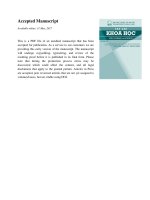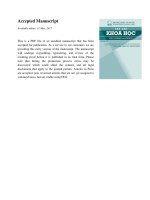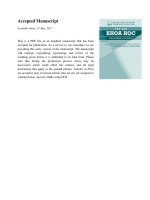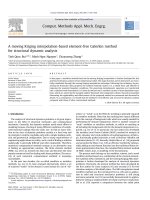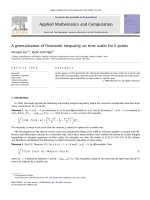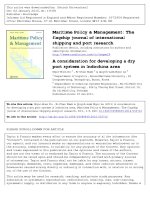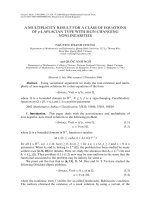DSpace at VNU: A finite difference scheme for nonlinear ultra-parabolic equations
Bạn đang xem bản rút gọn của tài liệu. Xem và tải ngay bản đầy đủ của tài liệu tại đây (180.21 KB, 7 trang )
Accepted Manuscript
A finite difference scheme for nonlinear ultra-parabolic equations
Vo Anh Khoa, Tuan Nguyen, Le Trong Lan, Nguyen Thi Yen Ngoc
PII:
DOI:
Reference:
S0893-9659(15)00056-7
/>AML 4726
To appear in:
Applied Mathematics Letters
Received date: 23 December 2014
Revised date: 9 February 2015
Accepted date: 10 February 2015
Please cite this article as: V.A. Khoa, T. Nguyen, L.T. Lan, N.T.Y. Ngoc, A finite difference
scheme for nonlinear ultra-parabolic equations, Appl. Math. Lett. (2015),
/>This is a PDF file of an unedited manuscript that has been accepted for publication. As a
service to our customers we are providing this early version of the manuscript. The manuscript
will undergo copyediting, typesetting, and review of the resulting proof before it is published in
its final form. Please note that during the production process errors may be discovered which
could affect the content, and all legal disclaimers that apply to the journal pertain.
A finite difference scheme for nonlinear ultra-parabolic equations
Vo Anh Khoaa , Tuan Nguyenb,∗, Le Trong Lanc , Nguyen Thi Yen Ngocc
a Mathematics
and Computer Science Division, Gran Sasso Science Institute, Viale Francesco Crispi 7, 67100, L’Aquila, Italy.
Analysis Research Group, Faculty of Mathematics and Statistics, Ton Duc Thang University, Ho Chi Minh City, Vietnam.
c Department of Mathematics, University of Science, Vietnam National University, 227 Nguyen Van Cu Street, District 5, Ho Chi Minh City, Viet Nam.
b Applied
Abstract
In this paper, our aim is to study a numerical method for an ultraparabolic equation with nonlinear source function. Mathematically, the bibliography on initial-boundary value problems for ultraparabolic equations is not extensive although the
problems have many applications related to option pricing, multi-parameter Brownian motion, population dynamics and so
forth. In this work, we present the approximate solution by virtue of finite difference scheme and Fourier series. For the nonlinear case, we use an iterative scheme by linear approximation to get the approximate solution and obtain error estimates. A
numerical example is given to justify the theoretical analysis.
Keywords and phrases: ultraparabolic equation, finite difference scheme, Fourier series, linear approximation, stability
Mathematics subject Classification 2000: 65L12; 65L80; 34A45; 34G20
1. Introduction
Let H be a Hilbert space with the inner product ·, · and the norm · . In this paper, we consider the problem of finding
u : [0, T ] × [0, T ] → H satisfies the following ultraparabolic equation
∂
∂
u (t, s) + u (t, s) + Au (t, s) = f (u (t, s) , t, s) ,
∂t
∂s
u (0, s) = ϕ (s) , s ∈ [0, T ],
u (t, 0) = ψ (t) , t ∈ [0, T ].
(t, s) ∈ (0, T ) × (0, T ) ,
(1.1)
where A : D(A) ⊂ H → H is a positive-definite, self-adjoint operator with compact inverse on H and ϕ, ψ are known smooth
functions satisfying ϕ(0) = ψ(0) for compatibility at (t, s) = (0, 0) and f is a source function which is defined later.
The problem (1.1) involving multi-dimensional time variables is called the initial-boundary value problem for ultraparabolic
equation. The ultraparabolic equation has many applications in mathematical finance (e.g. [6]), physics (such as multiparameter Brownian motion [16]) and biological models. Among many applications, the ultraparabolic equation arises as
a mathematical model of population dynamics. The study of ultraparabolic equation for population dynamics can be found
in some papers such as [5, 7]. In particular, Kozhanov [7] studied the existence and uniqueness of regular solutions and its
properties for an ultraparabolic model equation in the form of
∂u ∂u
+
− ∆u + h (x, t, s) u + Au = f (x, t, s) ,
∂t ∂s
where ∆ is Laplace operator, A is a nonlocal linear operator. In the same work, Deng and Hallam in [5] considered the age
structured population problem in the form of
∂u ∂u
+
− ∇ · (k∇u − qu) = −µu,
∂t ∂s
associated with non-locally integro-type initial-bounded conditions.
The ultraparabolic equation is also studied in many other aspects. In the study of inverse problems, Lorenzi [19] studied the
well-posedness of a class of forward problems for ultraparabolic partial integrodifferential equations. Very recently, Zouyed
and Rebbani [3] proposed the modified quasi-boundary value method to regularize a final value problem for (1.1) . For other
studies regarding the properties of solutions of abstract ultraparabolic equations, we can find many papers and some of them
are [8, 9, 11, 12, 13, 15].
Numerical methods for ultraparabolic equation are studied long time ago, for example [1, 2, 4, 14]. Since 1996, Akrivis,
Crouzeix and Thome [2] investigated a backward Euler scheme and second-order box-type finite difference procedure to
∗ Corresponding
Author. Email:
Preprint submitted to Elsevier
February 23, 2015
numerically approximate the solution to the Dirichlet problem for the ultraparabolic equation (1.1) in two different time
intervals with the Laplace operator A = −∆ and the source function f ≡ 0. As opposed to the method-of-lines approach
developed in [2], the well-posedness of the ultraparabolic problem, utilizing the directional derivative and demonstrated in
Tersenov et al. [1], yields a method-of-characteristics numerical scheme. Recently, Ashyralyev and Yilmaz [4] constructed
the first and second order difference schemes to approximate the problem (1.1) in case that f ≡ 0 for strongly positive operator
and obtained some fundamental stability results. On the other hand, Marcozzi et al. [14] developed an adaptive method-of(x) ∂u
(x, t, s) ,
lines extrapolation discontinuous Galerkin method for an ultraparabolic model equation given by ∂u
∂t +a
∂s −∆u = f
with a certain application to the price of an Asian call option. However, most of papers for numerical methods aim to study
linear cases. Equivalently, numerical methods for nonlinear equations are still limited. Motivated by this reason, in this
paper, we develop a finite difference method for a nonlinear ultraparabolic equation. Our method comes from the idea of
Ashyralyev et al. [4, 17], but it is different to their method. We remark that the numerical approach by Ashyralyev et al.
[4] is computationally expensive, especially using finite difference scheme in space. Normally, the matrices generated by
space-discretization are very big if the spatial dimension is high. Therefore, in this paper we shall study the model problem
(1.1) in the numerical angle for the smooth solution by a different approach in space. Theoretically, paying attention to the
idea of finite difference scheme in time, studied in e.g. [4, 17, 18] by Ashyralyev et al., and conveying a fundamental result
in operator theory, we construct an approximate solution for problem (1.1) in terms of Fourier series. .
The rest of the paper is organized as follows. In Section 2, a finite difference scheme is propsed. Furthermore, stability and
convergence of the proposed scheme is established. Finally, a numerical example is implemented in Section 3 to verify the
effectiveness of the method.
2. Finite difference scheme for nonlinear ultra parabolic : stability analysis
In this section, we consider a numerical method for Problem (1.1) in the case that f satisfies the global Lipschitz condition
f (u, t, s) − f (v, t, s) ≤ K u − v ,
(2.2)
where K is a positive number independent of u, v, t, s. By simple calculation analogous to the steps in linear nonhomogeneous
case, we get the discrete solution, then use linear approximation to get the explicit form of the approximate solution.
From now on, suppose that A : D(A) ⊂ H → H is a positive-definite, self-adjoint operator with a compact inverse in H. As a
consequence, A admits an orthonormal eigenbasis {φn }n≥1 in H, associated with the eigenvalues such that
0 < λ1 ≤ λ2 ≤ λ3 ≤ ... lim λn = ∞.
n→∞
With Gn (t, s) = exp
λn
(t + s) , by a simple computation, the problem (1.1) is transfomed into the following problem.
2
∂
∂
u (t, s) , φn Gn (t, s) = f (u (t, s) , t, s) , φn Gn (t, s) ,
∂t + ∂s
(2.3)
u (0, s) , φn Gn (t, s) = ϕ (s) , φn Gn (t, s) ,
u (t, 0) , φn Gn (t, s) = ψ (t) , φn Gn (t, s) .
For the numerical solution of this problem by finite difference scheme as introduced in the above section, a uniform grid of
mesh-points (t, s) = (tk , sm ) is used. Here tk = kω and sm = mω, where k and m are integers and ω the equivalent mesh-width
in time t and s. We shall seek a discrete solution uk,m = u (tk , sm ) determined by an equation obtained by replacing the time
derivatives in (2.3) by difference quotients. The equation in (2.3) becomes
u(tk , sm ), φn Gn (tk , sm ) − u(tk−1 , sm ), φn Gn (tk−1 , sm )
ω
= f (u(tk , sm ), tk , sm ) , φn Gn (tk , sm ) ,
u(tk−1 , sm ), φn Gn (tk−1 , sm ) − u(tk−1 , sm−1 ), φn Gn (tk−1 , sm−1 )
+
ω
(2.4)
and
u (0, sm ) , φn Gn (tk , sm ) = ϕ (sm ) , φn Gn (tk , sm ) ,
u (tk , 0) , φn Gn (tk , sm ) = ψ (t) , φn Gn (tk , sm ) .
By induction, it follows from (2.5) that
p
u(tk , sm ), φn Gn (tk , sm ) =
f u(tk−p+l , sm−p+l ), tk−p+l , sm−p+l , φn Gn tk−p+l , sm−p+l
ω
l=1
+ u(tk−p , sm−p ), φn Gn tk−p , sm−p
2
(2.5)
for all p ∈ N. Hence, we obtain that the explicit form of discrete solution of (1.1)
∞
u (tk , sm ) =
u (tk , sm ) , φn φn
(2.6)
n=1
where u (tk , sm ) , φn is given by
u (tk , sm ) , φn
ω
=
ω
m
l=1
f (u(tk−m+l , sl ), tk−m+l , sl ) , φn Gn (tk−m+l , sl ) + ψ(tk−m ), φn Gn (tk−m , s0 )
Gn (tk , sm )
k
l=1
f (u(tl , sm−k+l ), tl , sm−k+l ) , φn Gn (tl , sm−k+l ) + ϕ(sm−k ), φn Gn (t0 , sm−k )
Gn (tk , sm )
, if k > m
, if m > k.
From now on, we shall give an iterative scheme by linear approximation. Choosing u0 (tk , sm ) = 0, from uq (tk , sm ) ∈ H,
we shall use the Fourier series to express it in the form
∞
uq (tk , sm ) =
uq (tk , sm ) , φn φn
(2.7)
n=1
where uq (tk , sm ) , φn is defined by
uq (tk , sm ) , φn
ω
=
ω
m
l=1
f uq−1 (tk−m+l , sl ), tk−m+l , sl , φn Gn (tk−m+l , sl ) + ψ(tk−m ), φn Gn (tk−m , s0 )
Gn (tk , sm )
k
l=1
f uq−1 (tl , sm−k+l ), tl , sm−k+l , φn Gn (tl , sm−k+l ) + ϕ(sm−k ), φn Gn (t0 , sm−k )
Gn (tk , sm )
, if k > m
, if m > k.
Here uq (tk , sm ) is called the approximate solution for the problem (1.1). Our results are to prove that this solution approach
to the discrete solution u(tk , sm ) in norm H as q → ∞ and study the stability estimate of uq (tk , sm ) in norm H with respect to
the initial data and the right hand side f uq−1 .
Theorem 2.1. Let uq (tk , sm )
sup
1≤k,m≤M
2
uq (tk , sm )
q≥1
be the iterative sequence defined by (2.7). Then, it satisfies the a priori estimate
≤ CT
sup
1≤k,m≤M
uq−1 (tk , sm )
2
+ sup
1≤k,m≤M
f (0, tk , sm )
2
+ sup
0≤m≤M
ϕ(sm )
2
+ sup ψ(tk )
2
,
0≤k≤M
where CT is a positive constant depending only on T .
Proof. We divide two cases
Case 1: k > m. Using Parseval’s identity in (2.7) for the case k > m, we have
uq (tk , sm )
2
≤
≤
≤
2
2ω
m
∞
n=1 l=1
Gn (tk−m+l , sl )
f uq−1 (tk−m+l , sl ), tk−m+l , sl , φn
Gn (tk , sm )
∞
2ω2 m2 sup
1≤k,m≤M n=1
2T 2 sup
1≤k,m≤M
f uq−1 (tk , sm ), tk , sm , φn
f uq−1 (tk , sm ), tk , sm
2
2
+ 2 sup
2
+2
∞
n=1
∞
0≤k≤M n=1
Gn (tk−m , s0 )
ψ(tk−m ), φn
Gn (tk , sm )
ψ(tk ), φn
2
2
+ 2 sup ψ(tk ) 2 .
(2.8)
0≤k≤M
Case 2: m > k. Similarly, we can deduce for the case k < m that
uq (tk , sm )
2
≤ 2T 2 sup
1≤k,m≤M
f uq−1 (tk , sm ), tk , sm
2
+ 2 sup
0≤m≤M
ϕ(sm ) 2 .
(2.9)
Moreover, from the condition (2.2), we have
f uq−1 (tk , sm ), tk , sm
≤
≤
f uq−1 (tk , sm ), tk , sm − f (u0 (tk , sm ), tk , sm ) + f (u0 (tk , sm ), tk , sm )
K uq−1 (tk , sm ) − u0 (tk , sm ) + f (0, tk , sm ) .
3
(2.10)
Combining (2.8)-(2.10) and putting CT = max 2T 2 K 2 + 1 ; 2 , we get
sup
1≤k,m≤M
uq (tk , sm )
2
≤ 2T 2 K 2 + 1
≤ CT
sup
sup
2
uq−1 (tk , sm )
1≤k,m≤M
2
uq−1 (tk , sm )
1≤k,m≤M
f (0, tk , sm )
+ sup
1≤k,m≤M
2
f (0, tk , sm )
+ sup
1≤k,m≤M
+ sup
0≤m≤M
2
+2
ϕ(sm )
sup
0≤m≤M
2
ϕ(sm )
2
+ sup ψ(tk )
2
0≤k≤M
+ sup ψ(tk )
2
.
0≤k≤M
Remark 2.1. If f (u(t, s), t, s) ≡ f (t, s), then for k > m, since Gn (tk−m+l , sl ) ≤ Gn (tk , sm ) and Gn (tk−m , s0 ) ≤ Gn (tk , sm ) we
have following estimate
u (tk , sm )
2
≤ 2ω2
m
l=1
∞
f (tk−m+l , sl ) , φn Gn (tk−m+l , sl )
Gn (tk , sm )
n=1
≤
2m2 ω2 sup
≤
2T 2 sup
∞
≤ 2 max{T 2 , 1}
+2
2
+2
∞
2
Gn (tk , sm )
2
ψ(tk−m ), φn
n=1
2
f (tk , sm )
1≤k,m≤M
ψ(tk−m ), φn Gn (tk−m , s0 )
∞
n=1
f (tk , sm ) , φn
1≤k,m≤M n=1
2
2
f (tk , sm )
sup
1≤k,m≤M
2
+ 2 ψ(tk−m )
≤ 2 max{T 2 , 1}
+ sup
0≤m≤M
ϕ(sm )
2
sup
1≤k,m≤M
f (tk , sm )
+ sup ψ(tk )
2
2
+ sup ψ(tk )
2
0≤k≤M
(2.11)
.
0≤k≤M
For m > k, we have a similar proof.
Theorem 2.2. Let the source function f of the problem (1.1) satisfying the Lipschitz condition (2.2). Then, the iterative
sequence uq (tk , sm ) defined by (2.7) strongly converges to the discrete solution u(tk , sm ) (2.6) of (1.1) in norm H in the sense
of
κTq
sup uq (tk , sm ) − u(tk , sm ) ≤
sup u1 (tk , sm ) ,
1 − κT 1≤k,m≤M
1≤k,m≤M
where κT < 1 is a positive constant depending only on T .
Proof. For short, we denote f k,m uk,m = f (u(tk , sm ), tk , sm ). Putting wqk,m = uq+1 (tk , sm ) − uq (tk , sm ), it follows from (2.7) that
for k > m we have
uq+1 (tk , sm ) − uq (tk , sm )
2
2
≤
ω
≤
ω2 m2 sup
≤
2
m
∞
n=1 l=1
f uq (tk−m+l , sl ), tk−m+l , sl − f uq−1 (tk−m+l , sl ), tk−m+l , sl , φn
f uq (tk , sm ), tk , sm ) − f uq−1 (tk , sm ), tk , sm
1≤k,m≤M
2
T K
2
sup
1≤k,m≤M
uq (tk , sm ) − uq−1 (tk , sm )
2
2
.
Thus, we get uq+1 (tk , sm ) − uq (tk , sm ) ≤ T K sup1≤k,m≤M uq (tk , sm ) − uq−1 (tk , sm ) . We can always choose T > 0 small
enough such that κT := T K < 1. Then, we have
uq+r (tk , sm ) − uq (tk , sm )
≤
uq+r (tk , sm ) − uq+r−1 (tk , sm ) + ... + uq+1 (tk , sm ) − uq (tk , sm )
≤ κTq+r−1 sup
1≤k,m≤M
u1 (tk , sm ) − u0 (tk , sm ) + ... + κTq
≤ κTq κTr−1 + κTr−2 + ... + 1
≤
Therefore, we obtain
κTq 1 − κTr
1 − κT
sup
1≤k,m≤M
sup
1≤k,m≤M
sup
1≤k,m≤M
u1 (tk , sm ) − u0 (tk , sm )
u1 (tk , sm )
u1 (tk , sm ) .
κTq
uq+r (tk , sm ) − uq (tk , sm ) ≤
1 − κT
4
sup
1≤k,m≤M
u1 (tk , sm ) ,
(2.12)
which leads to the claim that uq (tk , sm ) is a Cauchy sequence in H and then, there exists uniquely u(tk , sm ) ∈ H such that
uq (tk , sm ) → {u(tk , sm )} as q → ∞. Because of this convergence and Lipschitz property (2.2) of nonlinear source term f ,
it is easy to prove that f uq (tk , sm ) → f (u(tk , sm )) as q → ∞. Therefore, u(tk , sm ) is the discrete solution of the problem
(P).(1.1). When r → ∞, it follows (2.12) from that
uq (tk , sm ) − u(tk , sm ) ≤
κTq
1 − κT
sup
1≤k,m≤M
u1 (tk , sm ) .
For m > k, we also have a similar proof. Hence, we complete the proof of the theorem.
3. Numerical example
In this section, we are going to show a numerical example in order to validate the efficiency of our scheme. It will be
observed by comparing the results between numerical and exact solutions. We shall choose given functions in such a way
that they lead to a given exact solution. The example is involved with the Hilbert space H = L2 (0, π) and associated with
homogeneous boundary conditions. On the other hand, numerical results with many 3-D graphs shall be discussed in the last
subsection. Now we take the following problem as an example for the nonlinear case with f the Lipschitz function.
ut (x, t, s) + u s (x, t, s) − u xx (x, t, s) + u (x, t, s) = f (u, x, t, s) , (x, t, s) ∈ (0, π) × 0, 41 × 0, 14 ,
, (t, s) ∈ 0, 41 × 0, 14 ,
u (0, t, s) = u x (π, t, s) = 0
u (x, 0, s) = ϕ (x, s)
, (x, s) ∈ [0, π] × 0, 14 ,
u (x, t, 0) = ψ (x, t)
, (x, t) ∈ [0, π] × 0, 14 ,
where
f (u, x, t, s) =
1
1
7x
sin (u) + 49h (x, t, s) − sin (h (x, t, s)) , ϕ (x, s) =
1 + e−s sin
,
4
4
2
ψ (x, t) =
1 −t
7x
e + 1 sin
4
2
7x
1 −t
∂
e + e−s sin
. With the operator L = − 2 +I and D (L) = v ∈ H 1 (0, π) ∩ H 2 (0, π) : v (0) = v x (π) = 0 ,
4
2
∂x
2
1
1
2
sin n +
x and λn = n +
+ 1. We shall give the iterative scheme (2.8) to get the approximate soluwe get φn =
π
2
2
tion uk,m
q = uq (tk , sm ) by the following steps.
Step 1. With q = 0: u0 (tk , sm ) = 0, 1 ≤ k, m ≤ M.
Step 2. Let proceed to the (q − 1) - time, we get uq−1 (tk , sm ), 1 ≤ k, m ≤ M. Then we shall obtain uq (tk , sm ), 1 ≤ k, m ≤ M as
follows.
For k > m:
and h (x, t, s) =
uq (tk , sm ) (x) =
where
Rk−m+l,l
=
q−1
m
ω
e
53
8 (tk +sm )
π
1
2π
0
53
e 8 (tk−m+l +sl ) Rk−m+l,l
sin
q−1
l=1
53
7x
1 53
7x
+ e− 8 (tk +sm ) e 8 tk−m e−tk−m + 1 sin
,
2
4
2
(x) − sin hk−m+l,l (x) sin
sin uk−m+l,l
q−1
7x
49 −tk−m+l
dx +
e
+ e−sl .
2
16
(3.13)
(3.14)
For m > k:
uq (tk , sm ) (x)
=
k
ω
e
53
8 (tk +sm )
53
e 8 (tl +sm−k+l ) Rl,m−k+l
sin
q−1
l=1
53
7x
1 53
7x
+ e− 8 (tk +sm ) e 8 sm−k 1 + e−sm−k sin
,
2
4
2
(3.15)
where
Rl,m−k+l
=
q−1
1
2π
π
0
l,m−k+l
(x) − sin hl,m−k+l (x) sin
sin uq−1
7x
49 −tl
dx +
e + e−sm−k+l .
2
16
(3.16)
Since (3.14) and (3.16) are hard to compute, we shall approximate them by using Gauss-Legendre quadrature method (see
π
7x j
j0
e.g. [10]). Particularly, they can be determined in the following form 0 H (x) sin 7x
j=0 w j H x j sin 2 , where x j
2 dx =
are abscissae in [0, π] and w j are corresponding weights, j0 ∈ N is a given constant. Denoting E = uex − u, we compute the
discrete l2 -norm and l∞ -norm of E by
E
l2
=
1
|G| χ
G ∈G
|E (χG )|2 ,
5
E
l∞
= max |E (χG )| ,
χG ∈G
(3.17)
(a)
(b)
Figure 1: The exact solution uex (x, t, s) =
shown in (b) at t =
1
.
4
7x
1 −t
e + e−s sin
shown in (a) in comparison with the approximate solution (3.13)-(3.15)
4
2
where G = {χG } is a set of (L + 1) M 2 points on uniform grid [0, π] × (0, T ] × (0, T ] and |G| cardinality of G.
In our computations, we always fix j0 = 5 and L = 20. The comparison between the exact solutions and the approximate
solutions for the examples respectively are shown in Figure 1 in graphical representations. As this figure, we can see that
the exact solution and the approximate solution are close together. Furthermore, convergence is observed from the computed
errors in Table 1, respectively, which is reasonable for our theoretical results.
Table 1: Numerical results (3.17) with j0 = 5, L = 20.
E
E
l2
l∞
q = 2, M = 50
5.8273E-3
1.1642E-2
q = 3, M = 100
2.9003E-3
5.8511E-3
q = 4, M = 200
1.4417E-3
2.9184E-3
q = 5, M = 400
7.1870E-4
1.4572E-3
References
[1] A. Tersenov, Basic boundary value problems for one ultraparabolic equation, Siberian Mathematical Journal, 42, p. 1173-1189, 2001.
[2] G. Akrivis, M. Crouzeix, and V. Thome, Numerical methods for ultraparabolic equations, Calcolo, vol. 31, no. 3-4, pp. 179190, 1996.
[3] F. Zouyed, F. Rebbani, A modified quasi-boundary value method for an ultraparabolic ill-posed problem, J. Inverse Ill-Posed Probl., Volume 0, 15693945, 2014.
[4] A. Ashyralyev and S. Yilmaz, An Approximation of Ultra-Parabolic Equations, Abstract and Applied Analysis, vol. 2012, Article ID 840621, 14 pages,
2012.
[5] Q. Deng , T. G. Hallam , An age structured population model in a spatially heterogeneous environment: Existence and uniqueness theory, Nonlinear
Anal. 2006; 65, 379-394.
[6] M. D. Francesco, A. Pascucci, A continuous dependence result for ultraparabolic equations in option pricing, J. Math. Anal. Appl. 336 (2007)
10261041.
[7] A. I. Kozhanov, On the Solvability of Boundary Value Problems for Quasilinear Ultraparabolic Equations in Some Mathematical Models of the
Dynamics of Biological Systems, Journal of Applied and Industrial Mathematics, 2010, Vol. 4, No. 4, pp. 512525.
[8] S. A. Tersenov, Well-posedness of boundary value problems for a certain ultraparabolic equation, Siberian Mathematical Journal, Vol. 40, No. 6, 1999.
[9] Alkis S. Tersenov, Ultraparabolic equations and unsteady heat transfer, J.evol.equ. 5 (2005) 277289.
[10] W. H. Press et al., Numerical recipes in Fortran 90, 2nd ed., Cambridge University Press, New York, 1996.
[11] V. S. Dron’ and S. D. Ivasyshen, Properties of the fundamental solutions and uniqueness theorems for the solutions of the Cauchy problem for one
class of ultraparabolic equations, Ukrainian Mathematical Journal, Vol. 50, No. 11. 1998.
[12] M. A. Ragusa, On weak solutions of ultraparabolic equations, Nonlinear Analysis 47 (2001) 503511.
[13] M. Bramanti and M. C. Cerutti, L p Estimates for Some Ultraparabolic Operators with Discontinuous Coefficients, Journal of Mathematical Analysis
and Applications 200, 332354 (1996).
[14] Michael D. Marcozzi, Extrapolation discontinuous Galerkin method for ultraparabolic equations, Journal of Computational and Applied Mathematics
224 (2009) 679687.
[15] Tarik Mohamed Touaoula and Noureddine Ghouali, Gradient Estimates for Solutions of Ultraparabolic Equations, Mediterr. j. math. 5 (2008), 101111.
[16] G. E. Uhlenbeck, L. S. Ornstein, On the theory of the Brownian motion, Phys. Rev. 36 (1930) 823-841.
[17] A. Ashyralyev, S. Yilmaz, Modified CrankNicholson difference schemes for ultra-parabolic equations, Computers and Mathematics with Applications
64 (2012) 27562764.
[18] A. Ashyralyev, S. Yilmaz, Second order of accuracy difference schemes for ultra parabolic equations, AIP Conf. Proc. , Vol. 1389, Jul. 2011, pp.
601-604.
[19] L. Lorenzi, An abstract ultraparabolic integrodifferential equation, LE MATEMATICHE, Vol. LIII (1998)-Fasc. II, pp. 401-435.
6
